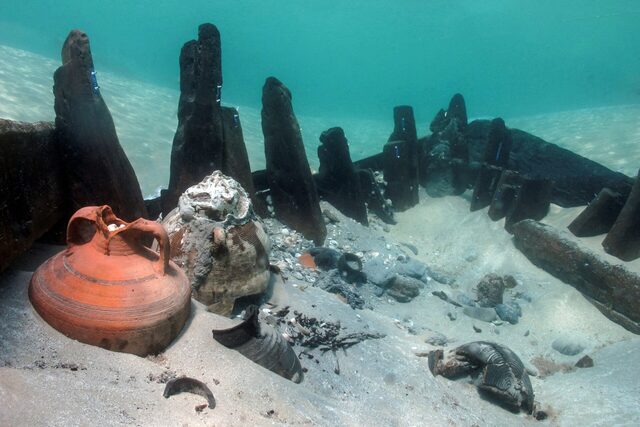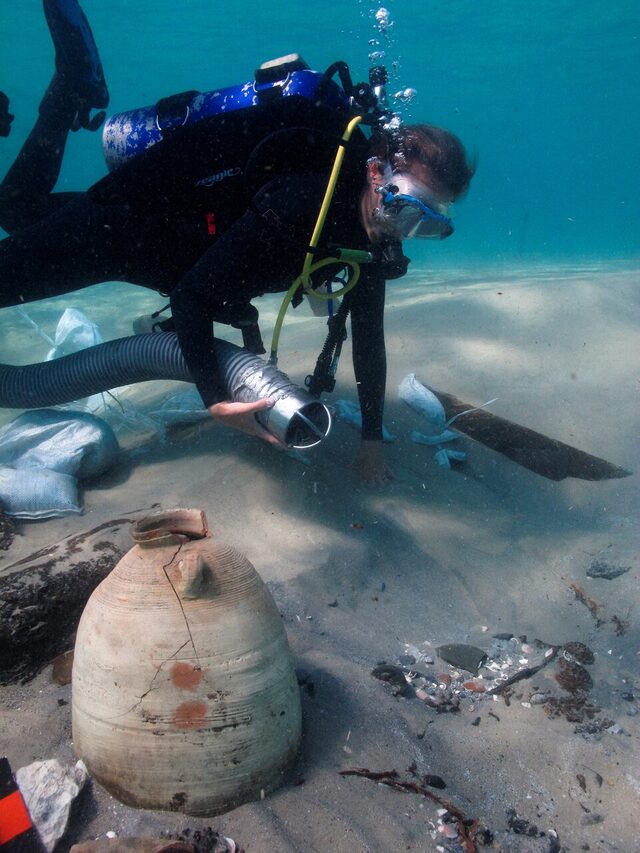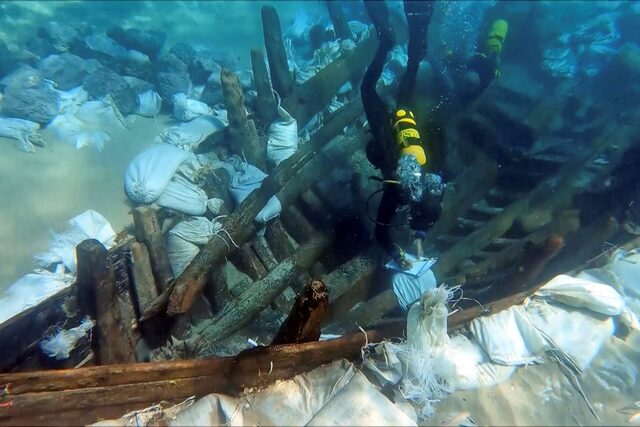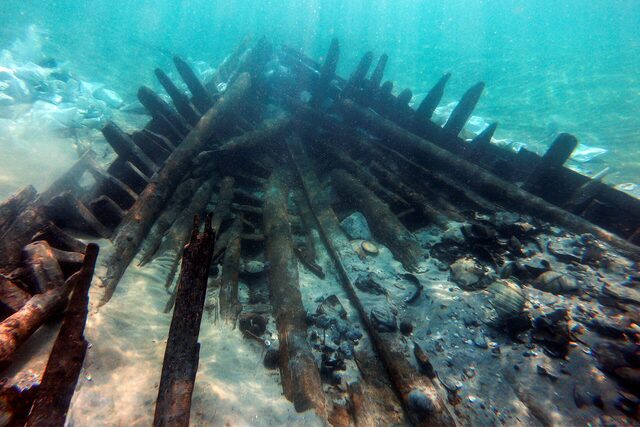An ancient shipwreck discovered off the coast of Israel is shedding new light on Mediterranean trade during a time of great political and religious transition. Unearthed in the Maagan Michael region, the ship’s cargo reveals a bustling trade network, challenging historical assumptions about the effects of the Islamic conquest on commerce in the region. This remarkable discovery, dated to the 7th or 8th century AD, offers a unique glimpse into a time when the Byzantine Empire was on the decline and Islamic rule was beginning to take hold. The shipwreck not only marks a crucial turning point in archaeological research but also illustrates the enduring tenacity of ancient traders.
The Maagan Michael Shipwreck: A Key Discovery
The shipwreck discovered in Maagan Michael is no ordinary find. Estimated to have been a 25-meter-long merchant vessel, this ancient ship once sailed across the Mediterranean, bringing with it a diverse cargo from distant lands. The ship’s wooden skeleton, made from fir and walnut trees, was discovered by amateur divers who noticed a piece of wood protruding from the sandy seabed. Over the course of eight excavation seasons, archaeologists have meticulously mapped out the ship’s remains, uncovering over 200 amphoras and numerous other artifacts. These items provide key insights into the trade practices of the Mediterranean, showing that despite the shifting political landscape, trade continued to thrive in this area.

Video
Watch the video as researchers reveal the secret discovery of a 17th-century shipwreck.
The Cargo: A Glimpse into Ancient Mediterranean Trade
The shipwreck’s cargo paints a fascinating picture of ancient Mediterranean trade. The artifacts found on the ship include amphoras, which are typically used to transport goods like wine, olive oil, and other commodities, as well as personal items such as wooden combs and sailing tools. More surprisingly, the cargo also includes symbols of both the Christian Byzantine church and Arabic writing. This mix of cultural artifacts reflects the complex nature of trade during a period when the Mediterranean was divided between competing religious and political powers. The presence of goods from Cyprus, Egypt, North Africa, and possibly Turkey suggests a continued and thriving trade network, even as the region underwent significant political changes.

The variety of items on board the ship further reinforces the idea that traders continued to maintain strong ties with distant regions. For example, the ship’s cargo contains ingredients that were staples in the Mediterranean diet, such as fish sauce, olives, dates, and figs, showcasing the extensive reach of trade routes. This discovery serves as evidence that, despite the rise of Islamic rule in the region, Mediterranean commerce was far from coming to a halt.
The Role of the Sea in Preservation
One of the reasons why this discovery is so well-preserved is the shallow depth of the waters off Israel’s coast. The sandy bottom of the sea has acted as a natural preservative, keeping many shipwrecks intact for centuries. The shallow waters make it easier for archaeologists to study shipwrecks that would otherwise be inaccessible in deeper parts of the Mediterranean. Over the millennia, countless ships have sunk off Israel’s coast, and many of them still lie beneath the sea, awaiting discovery.

The sandy seabed also protects the fragile artifacts, ensuring that items like amphoras and other cargo remain well-preserved. Archaeologists have used a range of tools, including underwater vacuums, to clear away the sand and uncover the items buried beneath. This method has allowed for the identification of over 200 amphoras, each one holding traces of the Mediterranean diet. Through careful excavation, archaeologists are piecing together the story of a merchant ship that once carried goods across a sea that connected diverse cultures, religions, and empires.
Challenging Historical Assumptions: The Persistence of Mediterranean Trade
This discovery challenges the traditional narrative of a decline in Mediterranean trade after the rise of Islam. Historians have long assumed that international commerce in the region significantly diminished during this period, with smaller coastal vessels taking over the trade routes. However, the Maagan Michael shipwreck offers compelling evidence to the contrary. This large merchant ship, laden with goods from across the Mediterranean, suggests that trade persisted even during a time of great political upheaval.
Deborah Cvikel, a nautical archaeologist at the University of Haifa and director of the excavation, points out that history books often depict the period after the Islamic conquest as one of trade stagnation. Yet, this shipwreck contradicts that view, showing that large-scale trade continued between the Mediterranean’s eastern and western regions. The cargo found on board, with its mix of Christian and Islamic symbols, further highlights the cross-cultural exchanges that were happening despite the political divide.

Further Excavations and Future Discoveries
The discovery of the Maagan Michael shipwreck is just one piece of the puzzle. Archaeologists continue to explore the region, and the ongoing excavation promises even more revelations about ancient trade. Researchers have already mapped out much of the ship’s 65-foot-long wooden skeleton, and with further excavation, there is hope of uncovering more items that could provide additional insights into the ship’s journey and the people who sailed it.
The excavation also presents an exciting opportunity for future research into the broader context of Mediterranean trade during the 7th and 8th centuries. The more artifacts that are uncovered, the clearer the picture will become of how trade networks operated and how they adapted to changing political conditions. The shipwreck at Maagan Michael could be a key piece in understanding the persistence of Mediterranean commerce, even as empires shifted and new political forces emerged.
The Legacy of the Maagan Michael Shipwreck
This discovery will leave a lasting legacy in the field of archaeology. It offers new insights into the resilience of ancient Mediterranean traders, who continued to engage in cross-cultural commerce even as political power shifted in the region. The shipwreck also demonstrates the importance of the sea in preserving archaeological artifacts, as the shallow waters off Israel’s coast continue to yield remarkable finds. In addition to its historical significance, the discovery contributes to our broader understanding of Mediterranean trade during a time of transition, adding depth to our knowledge of the ancient world.
Video
Watch the video about the discovery of a ‘cursed’ sunken British ship, found intact after 90 years.
Conclusion: A Window into Ancient Mediterranean History
The Maagan Michael shipwreck is a remarkable find that challenges long-held assumptions about Mediterranean trade and provides new insights into the resilience of ancient traders. The cargo, which spans a range of cultures and regions, offers compelling evidence that trade continued to thrive even as the Islamic Empire extended its reach over the Holy Land. The discovery is a reminder of the dynamic and interconnected nature of the ancient Mediterranean world, where commerce persisted despite political divisions. As further excavations uncover more artifacts, the Maagan Michael shipwreck will continue to contribute to our understanding of ancient trade networks and the people who relied on them to sustain their societies.



